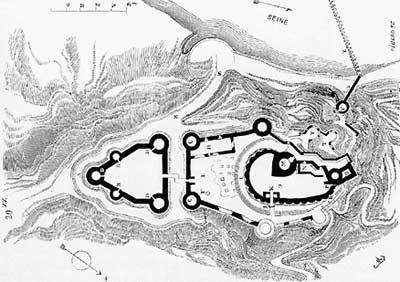Château Gaillard
The Siege of Chateau Gaillard
 Constructed in little more than 12 months by Richard I of England (”The Lionheart”), Chateau Gaillard was an imposing castle upon the French landscape, built to deter King Philip Augustus of France from invading Richard’s Norman territories. The stronghold was placed along the Seine River on a cliff extending above the towns of Grand and Petit Andelys, and built such that an invading army could only assault it from one direction, from the strip of land linking the rocky spur to the plateau beyond.
Constructed in little more than 12 months by Richard I of England (”The Lionheart”), Chateau Gaillard was an imposing castle upon the French landscape, built to deter King Philip Augustus of France from invading Richard’s Norman territories. The stronghold was placed along the Seine River on a cliff extending above the towns of Grand and Petit Andelys, and built such that an invading army could only assault it from one direction, from the strip of land linking the rocky spur to the plateau beyond.
The castle had three wards: an inner ward laid out at the end of the spur near the cliffs and housing the living quarters and keep; the middle ward that included two towers protecting the entrance, a large chapel, latrines, and other mural towers; and the triangular outer ward that served essentially as a barbican, for to gain access to the castle, attackers had to go through the outer ward first. A dry moat separated the middle and outer ward, the two connected by a fixed bridge.
In the year 1203, Philip Augustus laid siege to the stronghold of Chateau Gaillard. To avoid starvation, Roger de Lacy, commander of the castle garrison, forced the elderly and the women and children to leave in order to conserve his food stores — his supplies were only sufficient for a year — and while the French army allowed one wave of villagers to pass through its lines, Philip Augustus would not allow a second group to pass, forcing the refugees to roam between the two camps in mid-winter, causing many to die from cold and starvation.
In the spring of 1204, the King of France ordered the assault on Chateau Gaillard. The French army hurled projectiles, and sappers undermined the base of a tower, and finally a section of the wall collapsed, and the French army stormed the breach and took the outer ward. The English retreated to the middle ward, and the French, now in control of the outer section of the castle, began their assault on the middle bailey, though crossing a dry moat under relentless fire would not prove so easy. They had to find another way to capture the castle.
As luck would have it, the French discovered an unguarded garderobe shaft on the cliff side, and some men crawled through and entered the chapel, and since the chapel was locked from the outside, they broke a window and climbed along the castle wall. Taking the English by surprise, the French soldiers killed several guards and then set fire to the buildings and lowered the drawbridge, and Philip’s army entered the outer ward, and the English retreated to their final line of defense: the inner ward and keep.
A trebuchet then pounded the thinner walls of the inner bailey, and weakened by the construction of mines and the relentless pounding of the siege machine, the castle walls finally collapsed, and then the French army rushed through the breach, and the English retreated to the keep, where 140 defenders ultimately surrendered and were taken prisoner, thus ending the months long siege of Chateau Gaillard.
Main Source:
J.E. Kaufmann, H.W Kaufmann, and Robert M. Jurga. The Medieval Fortress: Castles, Forts and Walled Cities of the Middle Ages. De Capo Press, 2001.
Additional Online Readings:
http://en.wikipedia.org/wiki/Ch%C3%A2teau-Gaillard
http://les-andelys.com/chateau-gaillard/
*Photo is a 3D Reconstruction of Chateau Gaillard by Jacques Martel Harnois

 |  |  |  |
 |  |  |  |
 |  |  |  |
 |  |  |  |
 |  |  |  |
 |  |  |  |
 |  |  |
Source : http://steventill.com/2008/02/09/the-siege-of-chateau-gaillard/
http://www.casteland.com/pfr/chateau/hnormand/eure/cgaillard/gaillard_desc.htm